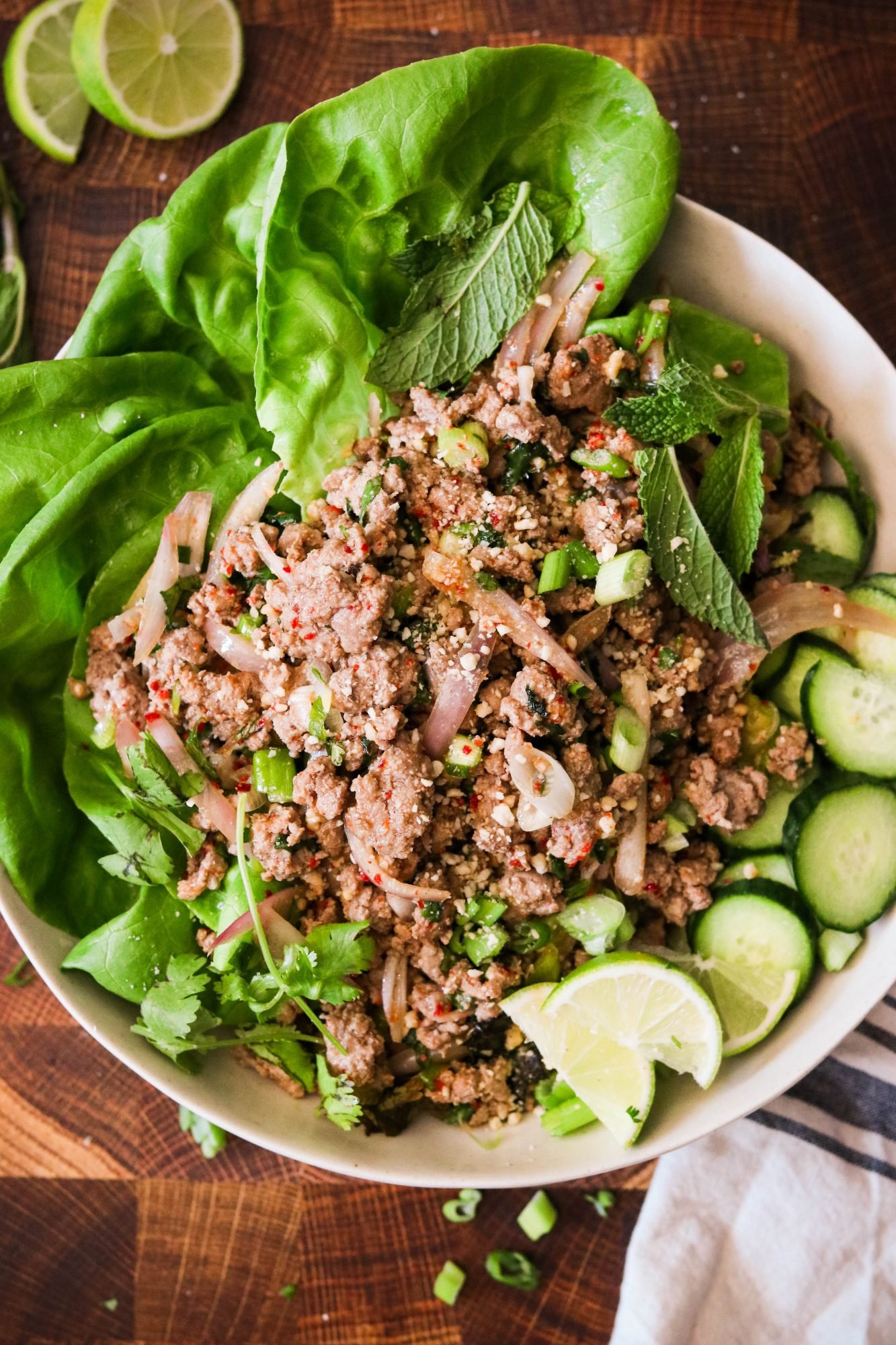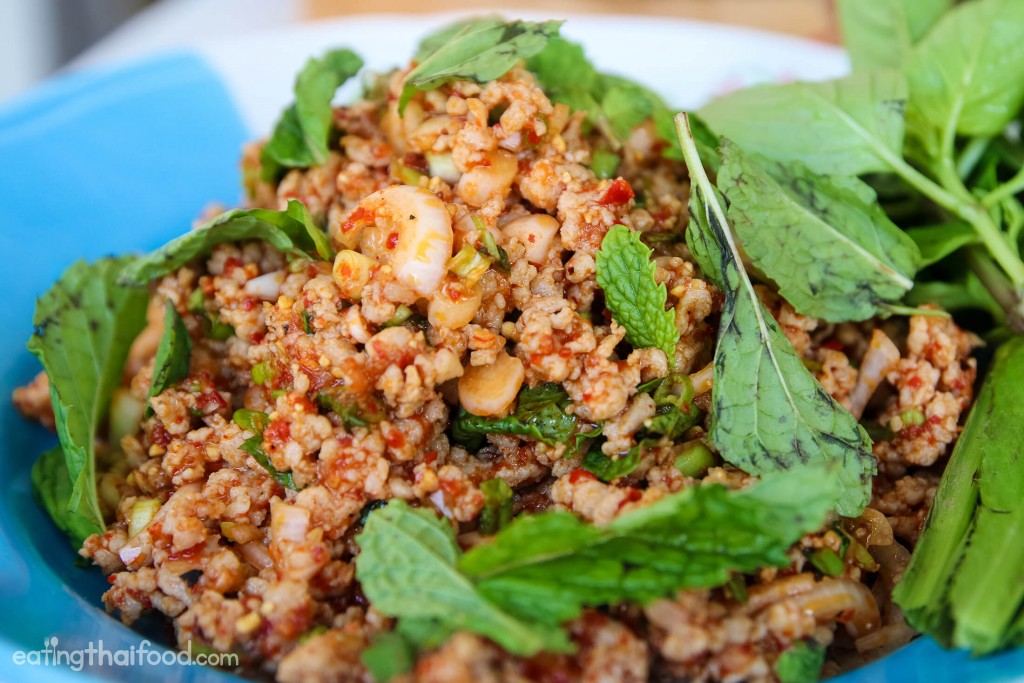A Deep Dive into Larb: Exploring Thailand’s Flavorful, Versatile Dish
Related Articles
- A Journey Through The World Of Dim Sum: Recipes, Techniques, And Culinary Delights
- A Journey Through Flavors: Exploring The World Of Seafood Paella
- Pasta Alla Vodka: A Journey Through Italy’s Culinary Landscape
- A Slice Of History: The Enduring Allure Of Pizza Margherita
- A Bite Of The Andes: The Story Of Ceviche, Peru’s National Treasure
Introduction
Uncover the latest details about A Deep Dive into Larb: Exploring Thailand’s Flavorful, Versatile Dish in this comprehensive guide.
A Deep Dive into Larb: Exploring Thailand’s Flavorful, Versatile Dish

Larb, pronounced "laap" in Thai, is more than just a dish; it’s a culinary adventure. This vibrant, aromatic salad, typically featuring ground meat, herbs, and a symphony of spices, is a testament to the ingenuity of Thai cuisine. Its simplicity belies its complexity, offering a canvas for culinary creativity, allowing for endless variations based on regional preferences and personal tastes. This article will delve into the fascinating world of larb, exploring its history, ingredients, variations, and the art of crafting this delicious dish.
A Culinary Journey Through Time: The History of Larb
Larb’s origins trace back to the Isaan region of northeastern Thailand, a land influenced by Laotian culture. The dish likely emerged as a practical solution for utilizing readily available ingredients, particularly meat from hunting expeditions. The combination of minced meat, herbs, and spices, seasoned with lime juice and fish sauce, would have provided a nourishing and flavorful meal.
The use of minced meat, a characteristic of larb, reflects the influence of Laotian traditions, where similar dishes like "laap" are prevalent. The incorporation of herbs and spices, like lemongrass, chilies, and mint, reflects the abundant natural resources of the region. The dish’s adaptability, allowing for variations based on available ingredients and local preferences, reflects the resourceful spirit of the Isaan people.
Over time, larb has transcended its regional roots, becoming a beloved dish across Thailand and even gaining international recognition. Its adaptability and versatility have made it a culinary favorite, inspiring chefs and home cooks alike to experiment with different ingredients and techniques.
Exploring the Core Ingredients: The Building Blocks of Larb
While the exact ingredients may vary depending on the region and individual preferences, the fundamental components of larb remain consistent:
1. Meat: The most common meat used in larb is ground pork, but other options like chicken, beef, duck, or even fish are frequently used. The meat is typically ground or finely minced, allowing for a quick and even cooking process.
2. Herbs and Spices: The vibrant flavors of larb are largely attributed to the generous use of herbs and spices. Key ingredients include:
* **Lemongrass:** This aromatic herb adds a citrusy and slightly peppery flavor to the dish. * **Chilies:** The level of heat in larb is customizable, with options ranging from mild to fiery. Popular chilies include bird's eye chilies, Thai chilies, and chili flakes.
* **Mint:** Fresh mint leaves add a refreshing and cooling element to the dish, balancing the heat and richness of the meat.
* **Thai Basil:** This fragrant herb provides a sweet and slightly spicy aroma that complements the other flavors.
* **Shallots:** These small onions add a pungent and slightly sweet flavor to the dish.
* **Fish Sauce:** This fermented fish sauce provides a salty and umami depth to the dish.
* **Chilies:** The level of heat in larb is customizable, with options ranging from mild to fiery. Popular chilies include bird's eye chilies, Thai chilies, and chili flakes.
* **Mint:** Fresh mint leaves add a refreshing and cooling element to the dish, balancing the heat and richness of the meat.
* **Thai Basil:** This fragrant herb provides a sweet and slightly spicy aroma that complements the other flavors.
* **Shallots:** These small onions add a pungent and slightly sweet flavor to the dish.
* **Fish Sauce:** This fermented fish sauce provides a salty and umami depth to the dish.3. Lime Juice: Lime juice plays a crucial role in larb, adding a tart and tangy flavor that balances the richness of the meat and the heat of the spices. It also helps to tenderize the meat and create a more refreshing taste.
4. Sticky Rice: While not a direct ingredient in the larb itself, sticky rice is an essential accompaniment. It provides a contrasting texture and is used to scoop up the flavorful larb, enhancing the dining experience.
Unveiling the Variations: A Tapestry of Flavors
Larb’s adaptability shines in its diverse variations. While the core ingredients remain consistent, regional preferences and individual creativity have led to a multitude of variations. Here are some notable examples:
1. Larb Moo: This classic version features ground pork as the primary protein source. It’s a popular choice in Isaan, where it’s often served with sticky rice and various side dishes.
2. Larb Gai: Chicken takes center stage in this version, offering a lighter and more delicate flavor profile. It’s often served with a dipping sauce made with fish sauce, lime juice, and chilies.
3. Larb Pla: Fish, typically grilled or pan-fried, is used in this variation, offering a unique flavor and texture. It’s often served with a spicy dipping sauce and fresh herbs.
4. Larb Nua: This variation features ground beef, offering a richer and more robust flavor. It’s often served with a spicy dipping sauce and a side of vegetables.
5. Larb Ped: Duck, known for its rich and flavorful meat, takes the lead in this version. It’s often served with a sweet and savory dipping sauce and a side of vegetables.

6. Larb Vegetarian: This variation caters to vegetarian preferences, using tofu or mushrooms as the primary protein source. It’s often served with a variety of vegetables and a flavorful dipping sauce.
Mastering the Art of Cooking Larb: A Step-by-Step Guide
While the process of making larb may seem straightforward, there are subtle nuances that can elevate the dish to new heights. Here’s a detailed guide to crafting a delicious and authentic larb:
1. Prepare the Meat:
- Grounding: If using whole meat, grind it finely using a meat grinder or a food processor.
- Marination: Marinate the ground meat with fish sauce, lime juice, and a pinch of salt. This helps to tenderize the meat and infuse it with flavor.
2. Sauté the Spices and Herbs:
- Aromatic Base: Heat a pan over medium heat and add a generous amount of chopped shallots, lemongrass, and chilies. Sauté until fragrant, about 2-3 minutes.
- Spice Blending: Add a pinch of ground coriander, cumin, and black pepper to enhance the flavor profile.
3. Cook the Meat:
- High Heat: Add the marinated meat to the pan and cook over high heat, breaking it up with a spoon or spatula.
- Even Cooking: Cook until the meat is cooked through, about 5-7 minutes.
4. Combine and Season:
- Herb Infusion: Add chopped mint, Thai basil, and cilantro to the pan. Toss to combine.
- Lime Juice Balance: Pour in lime juice, adjusting the amount to achieve your desired level of tartness.
- Final Seasoning: Season with additional fish sauce and sugar to taste.
5. Serve with Sticky Rice:
- Classic Pairing: Serve the larb over a bed of sticky rice, allowing the flavors to mingle and create a harmonious taste sensation.
- Side Dishes: Accompany the larb with a variety of side dishes, such as sliced cucumbers, tomatoes, onions, and a dipping sauce made with fish sauce, lime juice, and chilies.
Culinary Tips and Tricks: Elevating Your Larb Experience
1. Freshness First: The key to a flavorful larb lies in the use of fresh, high-quality ingredients. Choose herbs and spices that are vibrant and aromatic, and use meat that is properly stored and handled.
2. Embrace the Heat: Larb is known for its spicy kick. Don’t be afraid to experiment with different types of chilies and adjust the level of heat to your liking.
3. Balance the Flavors: The perfect larb is a delicate balance of sweet, sour, salty, and spicy flavors. Adjust the amount of lime juice, fish sauce, and sugar to achieve the desired taste profile.
4. Textural Contrast: The combination of soft, minced meat and crunchy herbs and vegetables adds a delightful textural contrast to the dish. Use a variety of herbs and vegetables to enhance the overall experience.
5. Explore the Possibilities: Don’t be afraid to experiment with different variations of larb. Use different types of meat, explore unique herbs and spices, and create your own signature recipe.
Beyond the Plate: Larb in Modern Cuisine
Larb has transcended its traditional boundaries, finding its way into modern kitchens and inspiring culinary innovation. Chefs around the world are incorporating larb elements into their dishes, creating fusion dishes that blend Thai flavors with other cuisines.
1. Larb-Inspired Salads: Larb’s vibrant flavors and textures lend themselves well to modern salads. Chefs are incorporating larb ingredients like ground meat, herbs, and spices into salads, creating a unique and flavorful twist on classic dishes.
2. Larb-Flavored Burgers: The bold flavors of larb can also be incorporated into burgers, adding a touch of exotic flair. Chefs are using larb-seasoned meat patties, topping them with fresh herbs and a spicy dipping sauce.
3. Larb-Infused Noodle Dishes: Larb’s aromatic spices and flavors pair well with noodles. Chefs are incorporating larb ingredients into noodle dishes, creating a flavorful and satisfying meal.
4. Larb-Inspired Cocktails: The refreshing and citrusy flavors of larb have inspired cocktail creations. Mixologists are using larb ingredients like lemongrass, chilies, and lime juice to create unique and flavorful cocktails.
Conclusion: A Culinary Journey of Flavor and Versatility
Larb is a testament to the ingenuity and creativity of Thai cuisine. Its simplicity belies its complexity, offering a canvas for culinary exploration. From its humble origins in Isaan to its modern adaptations in global kitchens, larb continues to captivate taste buds and inspire culinary innovation. Whether enjoyed as a traditional dish or reimagined in contemporary cuisine, larb remains a vibrant and flavorful testament to the richness of Thai culinary heritage.
Closure
Thank you for reading! Stay with us for more insights on A Deep Dive into Larb: Exploring Thailand’s Flavorful, Versatile Dish.
Make sure to follow us for more exciting news and reviews.
Feel free to share your experience with A Deep Dive into Larb: Exploring Thailand’s Flavorful, Versatile Dish in the comment section.
Keep visiting our website for the latest trends and reviews.






